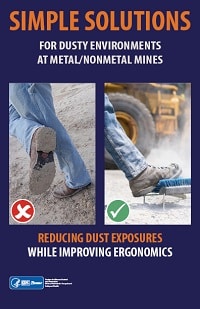Mining Publication: Simple Solutions for Dusty Environments at Metal/Nonmetal Mines
Original creation date: December 2021
Authors: J Patts, J Pollard, A Cecala, P Dempsey, A Louk, J Schall
NIOSHTIC2 Number: 20064161
Pittsburgh, PA: U.S. Department of Health and Human Services, Public Health Service, Centers for Disease Control and Prevention, National Institute for Occupational Safety and Health, DHHS (NIOSH) Publication No. 2022-107, 2021 Dec; :1-15
This booklet provides solutions that you can use to reduce exposure to dust at surface mines and facilities. Practical controls are presented that not only lower dust exposures but also reduce the risks for both musculoskeletal disorders (MSDs) and traumatic injuries (e.g., slips, trips, and falls). Beyond the obvious health benefits, it can be easier to justify engineering controls and interventions when greater impact can be achieved.
While traumatic injuries occur suddenly, both MSDs and respirable diseases tend to be the result of cumulative overexposures. Exposures both at home and at the workplace can combine and manifest themselves in the later years of your career, depending on your exposure rates and cumulative stress.
The information provided is based on experience gained within NIOSH and highlights solutions that are relatively low in cost and easy to implement. Dust control solutions that are practical to maintain have the greatest potential for sustained use and ultimately improved mine worker health and safety. This booklet is only a primer on dust control and injury prevention at metal/nonmetal mining operations. Additional resources are provided for more comprehensive coverage of these topics.
For Spanish speakers, download the same infographic with text in Spanish.

NIOSHTIC2 Number: 20064161
Pittsburgh, PA: U.S. Department of Health and Human Services, Public Health Service, Centers for Disease Control and Prevention, National Institute for Occupational Safety and Health, DHHS (NIOSH) Publication No. 2022-107, 2021 Dec; :1-15